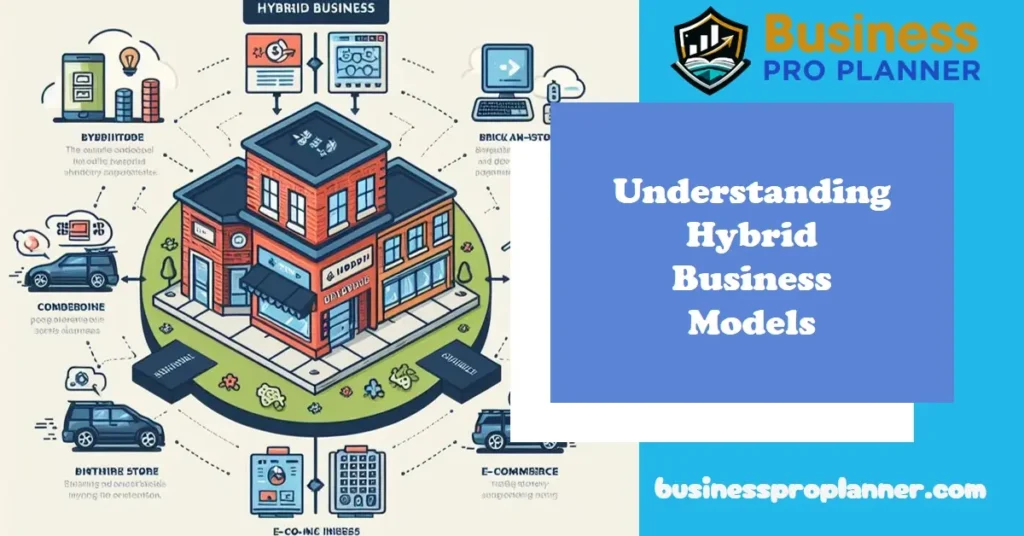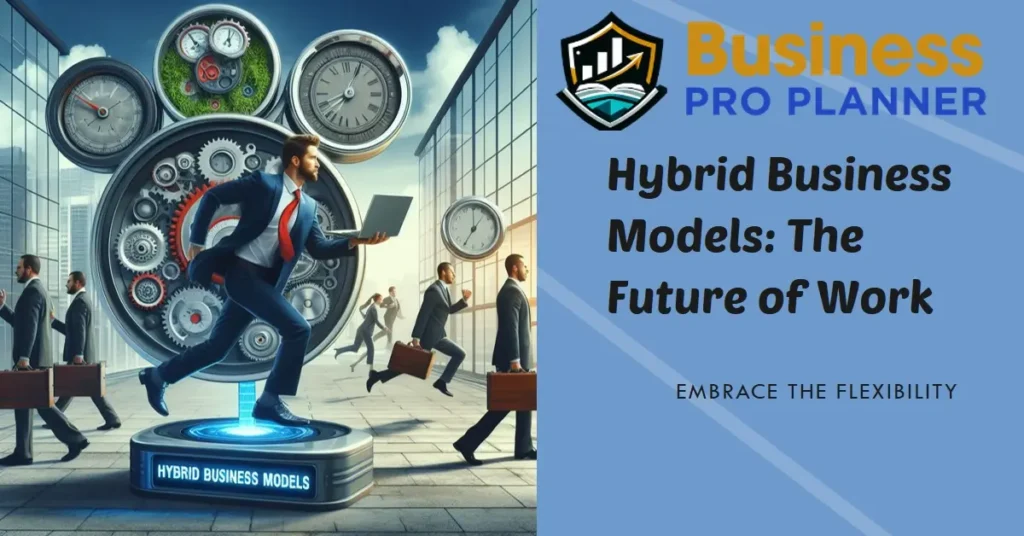The modern business landscape is rapidly evolving, fueled by trends like remote work, workforce diversification, and digital transformation. Consequently, numerous companies find that traditional business models are no longer adequate. This has led to hybrid business models that strategically blend multiple approaches to create flexibility and resilience.
Hybrid models allow businesses to tap the benefits of varied work arrangements, organizational structures, operations, and offerings within one integrated model. For instance, hybrid businesses may enable office-based and remote employees, to operate physical storefronts along with robust e-commerce, or pursue nonprofit-driven goals while still generating profits. These hybrid models aspire to address the varied needs of contemporary workers and customers.
The shift towards hybridity has accelerated recently, especially since COVID-19 compelled remote work and digital commerce. Even as things reopen, hybrid approaches are here to stay. By combining the best of both traditional and modern models, hybrid businesses position themselves to adapt and thrive in the ever-evolving work landscape.
What is a Hybrid Business Model?
A hybrid business model strategically blends multiple ways of working, managing, generating revenue, and delivering products and services. Some key characteristics include:

- Flexible work models that allow both fully remote employees and hybrid remote/office-based staff
- Centralized leadership and strategy combined with decentralized regional or business unit autonomy
- Nonprofit missions and/or community-focused goals with simultaneous for-profit elements
- Brick-and-mortar storefronts fully integrated with e-commerce and digital capabilities
In essence, a hybrid model combines varied approaches to create diversified offerings that provide the flexibility and personalization that employees and customers demand today.
The Evolution of the Hybrid Business Model
The hybrid business model has evolved significantly from traditional models where employees commuted to centralized offices and worked 9-5 on-site.
Enablers like cloud computing, videoconferencing, digital payment platforms, and online collaboration tools have allowed hybrid models that seamlessly blend physical and digital operations.
The shift has also been driven by increasingly diverse workforces and customer expectations around personalization. Hybrid approaches provide the flexibility needed for the modern economy.
Types of Hybrid Business Models
Several prevalent types of hybrid business models include:

- Work Model Hybrid: This model facilitates a flexible work arrangement, allowing employees to work remotely and from a central office location. Workers can split time between home and the office, or work remotely full-time coming to the office only periodically.
- Revenue Model Hybrid: Some hybrid businesses blend nonprofit and for-profit elements. For example, a social enterprise with both a community-focused mission as well as financial sustainability goals.
- Organizational Model Hybrid: A hybrid organizational model balances centralized strategic leadership with decentralized regional or business unit teams. The headquarters provides direction while local units operate autonomously.
- Operational Model Hybrid: Operationally hybrid businesses deliver products/services both digitally and in-person through channels like brick-and-mortar stores and e-commerce.
Key Components of a Hybrid Business Model
Successful hybrid businesses leverage a mix of the following essential elements:
- A flexible remote work policy allows employees to work partially or fully from home offices.
- Use of collaboration software to ensure effective communication between distributed teams.
- Investment in cybersecurity to protect confidential company data and customer information.
- Maintenance of office space for in-person meetings, onboarding, and group projects.
- Cloud infrastructure that enables seamless mobility and accessibility of systems remotely.
- A focus on results and accountability over physical presence through clear goals and targets.
- Strong company culture established through regular social interaction, training, and recognition.
The optimal mix of elements depends on your specific business context and strategy. Assess needs across operations, talent, and customers to determine the ideal hybrid configuration.
Examples of Hybrid Business Models
Here are noteworthy examples of companies effectively implementing hybrid business models:
Consultancy Firms:
Consulting firms enable remote work while utilizing office spaces for meetings, collaboration, and training. This hybrid approach allows them to recruit top talent from all over while maintaining face-to-face interaction and company culture.
Software Companies:
Many software product and service companies have hybrid models where a portion of the workforce works remotely full-time while others come into coworking spaces or headquarters offices periodically for meetings, projects, etc. For example, programming teams work remotely while sales and marketing teams visit offices regularly.
Non-Profits:
Non-profits with a social mission often operate hybrid models. This allows employees to work flexibly around volunteer activities while utilizing communal workspaces for networking and partnership building. It also helps manage costs in this sector.
Traditional Companies:
The COVID-19 pandemic accelerated the shift to remote work, with many businesses discovering new efficiencies through hybrid models. Industries like banking, healthcare, education, and more now allow partial remote work schedules for roles that can be performed flexibly.
Pros and Cons of Hybrid Models
Adopting a hybrid approach offers a variety of benefits but also poses some challenges to address:
Pros:
- Attract and retain talent by providing location flexibility many employees desire today. Remove geographic barriers to recruit the best people.
- Reduce overhead costs like office space and commute reimbursements since less physical space is required.
- Achieve greater work-life balance with flexible schedules and reduced commuting time.
- Increase productivity by enabling employees to work when they are most focused. Eliminate commuting downtime.
- Appeal to diverse customer preferences regarding digital vs. in-person interactions and purchases. Meet customers however, they wish to engage.
- Expand reach by accessing remote markets and demographics you couldn’t reach with only physical locations. Broaden market scope.
Cons:
- Potential communication barriers and lack of spontaneous collaboration across dispersed teams.
- Building an engaging culture may take more effort with a distributed workforce. Some connections are harder remotely.
- Data security risks stem from employees working from home and accessing sensitive company data.
- Work hours may creep longer without set in-office schedules. Always being “on” can lead to burnout.
- Unsuitable for some roles like manufacturing that require hands-on equipment only present on-site
Challenges and Solutions in Hybrid Models
Hybrid models pose some unique challenges but businesses can implement solutions to address them:
Communication Barriers
- Foster connections through team building activities and requiring video for all virtual meetings.
- Invest in collaboration technologies and productive online work practices.
- Set expectations for responsiveness and promote overcommunication.
Weakened Company Culture
- Facilitate shared experiences with occasional gatherings and annual retreats.
- Promote social interactions through chat platforms and virtual coffee meetings.
- Hire cultural ambassadors across regions to spread company values.
Data Security Concerns
- Implement cybersecurity training for employees and multi-factor authentication.
- Restrict data access and use encryption, firewalls, and cloud security tools.
- Establish clear security policies and online access protocols.
How to Implement a Hybrid Business Model
Here are the key steps to transition existing companies or launch new businesses using hybrid models:
- Assess role suitability – Analyze which functions are amenable to remote work versus office-only roles.
- Update HR policies – Revise policies about remote work, equipment reimbursement, time tracking, reimbursements, and workplace flexibility.
- Equip hybrid workforce – Provide laptops, high-speed internet reimbursements, collaboration tools, and cybersecurity resources to enable remote productivity.
- Redesign workspaces – Rightsize office space needs and reconfigure available areas to support collaboration, training, and social interaction.
- Train managers – Educate people managers on expectations setting, performance management, and engagement strategies for distributed reports.
- Communicate changes – Sensitize employees through multiple channels about transition timelines, process changes, and tips for remote effectiveness.
- Establish clear guidelines – Prepare documentation on work hours, availability, response times, and project scheduling for a transparent role model.
- Optimize processes – Leverage workflow automation tools for approvals, version control, and document sharing to streamline hybrid coordination.
- Track and improve – Conduct periodic feedback surveys, monitor metrics, and refine hybrid approaches based on collected insights over time.
Successful Hybrid Business Models in Practice
Large and small firms across industries embrace hybrid models with their unique benefits. Here are examples:
- GitLab: The all-remote software company has over 1,200 employees worldwide working synchronously on one codebase using video calls and chat for collaboration. Their hybrid approach empowers global round-the-clock workflow.
- Automattic: WordPress.com owners follow an asynchronous hybrid model with independent self-managed employees functioning flexibly. Over 800 staff collaborate remotely using Slack channels and work on their schedules with great work-life fit.
- Greenhouse Software: The HR software provider switched to a hybrid model post-COVID-19, citing the benefits of recruiting from a larger pool, employee satisfaction, and cost savings. Offices serve creative functions while remote work offers flexibility.
- Bolt: The e-commerce company allows staff a flexible four-days-in-office weekly schedule or fully remote, helping them recruit globally and improve productivity with focus time at home offices. Hybrid policies aid work-life balance.
- Zapier: The 500+ software startup embraces remote-first hybridity. Offices serve for culture building and social functions usually optional for flexibility. Asynchronous communication through forums, projects, and help documentation enables collaboration.
These successful models illustrate how blending in-person and virtual modes reaps rewards. Thoughtful, empathetic hybrid policies tuned optimally to roles ensure high engagement and team unity across distributed setups.
The Future of Work: Hybrid Models Leading the Way
The shift towards hybrid approaches represents a fundamental evolution in the way organizations operate, sell, and structure work. While early hybrid models combined just a few elements, future iterations will increasingly blend:
- Physical and digital experiences for customers
- AI automation and human talent
- Gig workers and full-time employees
- Centralized teams and crowdsourced talent networks
- Data analytics and human intuition-based decision-making
Workplaces that embrace strategic hybridity position themselves to tap the benefits of multiple models while mitigating the downsides of any single approach. As the economy evolves, adaptable hybrid models provide the agility and resilience needed.

Conclusion
In the end, by adopting hybrid approaches, businesses can balance flexibility and in-person interaction amid changing workforce demands. This innovative spirit will help future-proof organizations and empower them to innovate, scale, and make social impacts sustainably.

